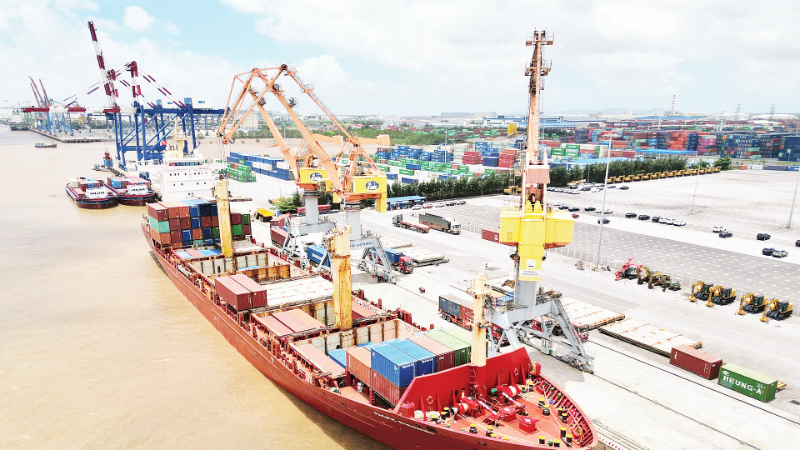Vietnamese logistics enterprises join the green transition race
Vietnamese logistics companies are facing the volatility of the global economy, from supply chain disruptions and rising transport costs to carbon tax barriers and environmental, social and governance (ESG) standards imposed by the European Union (EU).

This presents both challenges and opportunities for companies in this sector to undergo green transformation in order to make breakthroughs and reposition themselves in the global sustainable development race.
However, to realise the above-mentioned goals, logistics companies need support from the government through policies for sustainable infrastructure development, green finance, and emissions management.
Opportunities and challenges
The transport sector, particularly maritime transport, is currently a major emitter in the logistics field due to substantial fuel consumption, making the pressure for green transformation in the industry quite evident.
The International Maritime Organisation (IMO) has set a target to transition to fuels with lower emissions and reduced environmental impact, aiming for net-zero emissions by 2050. This is viewed as an opportunity for Viet Nam to take the lead in building a green and sustainable logistics model.
According to a World Bank report, Viet Nam’s annual logistics growth rate is 16%, and in 2023 Viet Nam ranked 43rd in the logistics performance index and was among the top five leading ASEAN countries.
Tran Thanh Hai, Deputy Director of the Import-Export Department under the Ministry of Industry and Trade stated that green logistics through investment in fuel-efficient transport vehicles, smart containers, route optimisation, and digitalisation of warehouse management not only helps realise sustainable development goals but also enables enterprises reduce long-term costs amid unpredictable fluctuations in oil prices and transport costs.
Furthermore, this is also a new standard for export markets, particularly as the EU has implemented the carbon border adjustment mechanism, which imposes taxes on high-emission goods. Therefore, once Vietnamese logistics enterprises secure green certificates, they create their own advantages in today’s highly competitive market.
In reality, Viet Nam’s logistics sector has many favourable conditions for development as the Party and government are very focused on investing in and expanding basic infrastructure, particularly transport, to help transport enterprises save time and shipping costs.
Furthermore, the boom in the retail market on e-commerce platforms (estimated at 25 billion USD in 2024, up 20% from the previous year) will be a driver and a great opportunity for logistics enterprises to capitalise on.
However, the journey of green transformation in logistics in Viet Nam is not at all easy when awareness, habits, and infrastructure have not truly met the requirements for the development of green vehicles.
Luu Thi Thanh Mau, Director General of Phuc Khang Investment and Construction Joint Stock Company noted that the commitment to achieve net-zero emissions by 2050 is placing Vietnamese enterprises, especially small and medium enterprises, under great pressure in efforts to green the supply chain.
Currently, the cost of investing in green technology, energy-efficient transport vehicles, or emissions management systems requires substantial capital, while most enterprises lack the necessary resources and expertise in selecting technology suitable for their finances and integration capabilities.
Along with this, the lack of experts with in-depth knowledge and practical implementation skills also creates obstacles for green technology application.
Coordination required from multiple parties
Clearly, all new fields face difficulties and challenges, but green transformation is not only a trend but also a mandatory requirement for sustainable economic development. Therefore, instead of retreating before difficulties, enterprises need to find suitable roadmaps to adapt and progress further.
Chairman of Macstar Group Tran Tien Dung revealed that, since 2023, the company has invested in large ships, established inland and coastal waterway transport groups, and piloted connections on the Hai Phong-Ninh Binh route by waterway.
This not only helps Macstar Group save costs, halve transport time, and significantly increase its carrying capacity, but also contributes to building a “green” image in the eyes of global partners.
Macstar Group is continuing to collaborate with partners to research larger cargo ships using environmentally friendly fuels such as solar batteries and green hydrogen to further reduce logistics costs and cut carbon emissions.
However, the company still needs support from the government on technical standards and guidance for applying new technology.
Koen Soenens, Vice Chairman of the Transport and Logistics Sector Committee of the European Chamber of Commerce in Viet Nam (EuroCham) stated that in Viet Nam, unsynchronised logistics infrastructure, inconsistent policies, and unclear regulations are hindering the green transformation process.
Therefore, coordination and collaboration between the government, enterprises, and relevant parties are required to jointly create a sustainable logistics ecosystem. Pressure from the global green transformation trend will be an important driver for Viet Nam to build a modern, sustainable logistics system, creating a foundation for a green economy.
Chairman of the Viet Nam Chamber of Commerce and Industry (VCCI) Pham Tan Cong emphasises that developing green logistics becomes an important advantage for Vietnamese enterprises to move faster and leap ahead in the global sustainable development strategy. This is a vital path, helping Vietnamese logistics enterprises enhance competitiveness amid uncertainties in the global economy.
He expressed his belief that with government support through policies, finance, and green technology, Vietnamese logistics enterprises can overcome challenges, transform pressure into opportunities to reposition value and enhance competitiveness, affirming their position on the world economic map.
It can be seen that the core of green logistics is building an integrated multimodal logistics model, coupled with policy frameworks and sustainable finances.
Therefore, to promote green logistics, the government needs to continue playing a facilitative role, issuing effective policies and guidance. The government should encourage enterprises to transition to waterway and railway transport to make use of high-capacity modes of transport, and to optimise processes by increasing transport scale, reducing empty runs, and developing smart warehouses and ports.
Enterprises also need to coordinate with management agencies to implement emission reduction roadmaps, invest in technology and clean energy; continue building sustainable development strategies, upgrade warehouses, invest in modern equipment, and prioritise environmentally friendly transport vehicles such as those using electricity from renewable sources, hydrogen or LNG.








